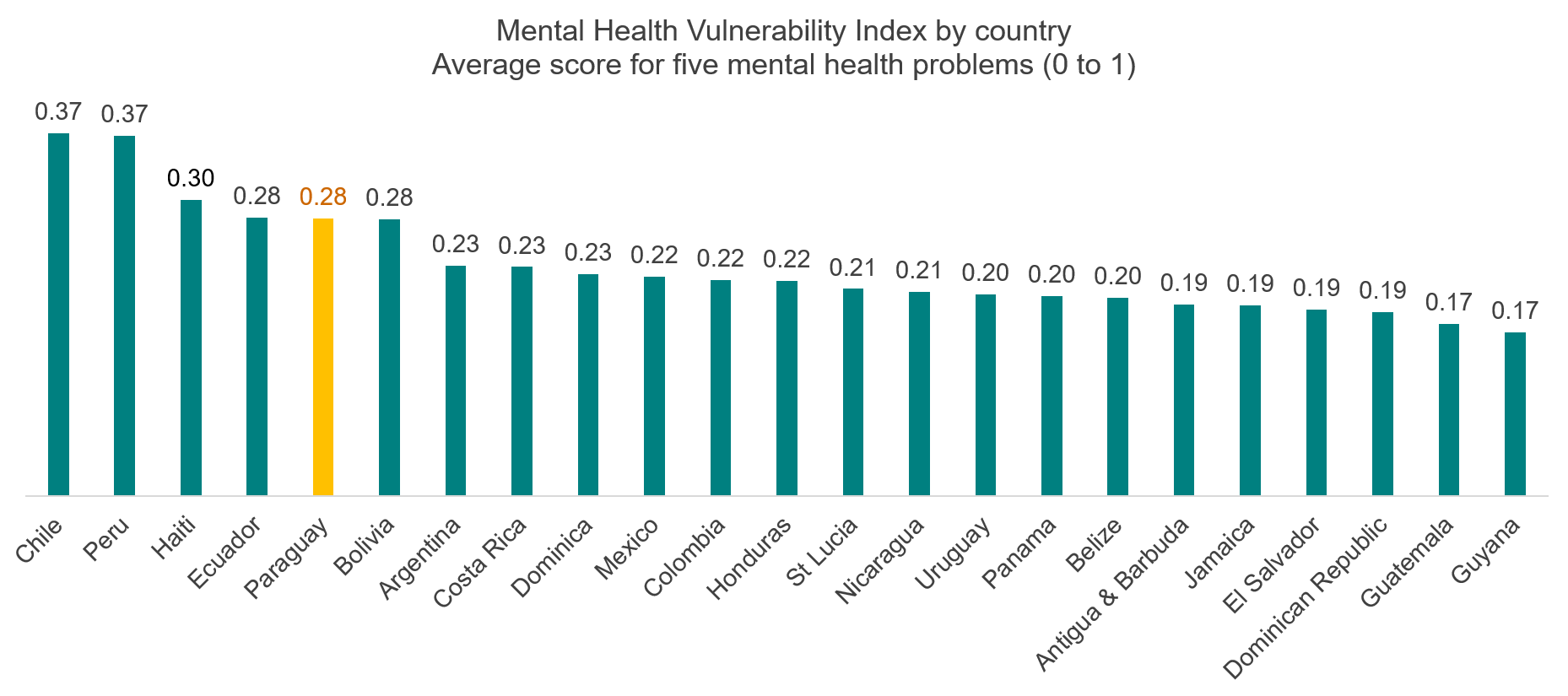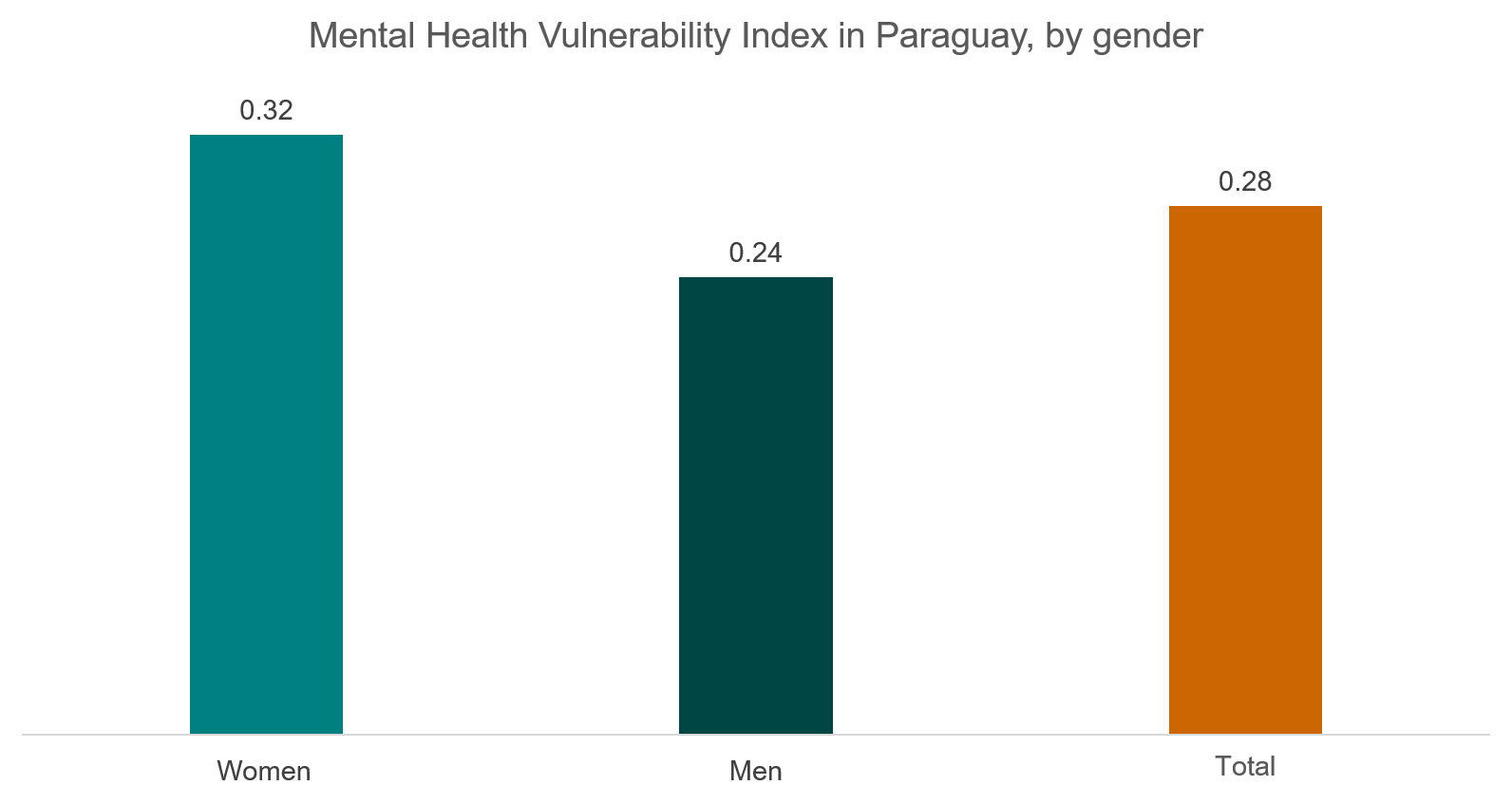 two street vendors
two street vendors
The Paraguayan way of being is full of positivity and serenity with a Guarani accent. Even in difficult times it is not uncommon to hear a Paraguayan say that everything is super tranquilo or iporãmbaite, in either Spanish or Guarani, with a broad smile, signaling that everything is going fine. Although this attitude denotes optimism, it can also overshadow the real state of well-being of people in the face of crises such as the pandemic we are experiencing when, beyond “everything is fine”, there are underlying threats to their mental health.
Between May and June 2021, the World Bank carried out High Frequency Phone Surveys (HFPS) in several Latin American and Caribbean countries with the aim of evaluating the impact of the pandemic on the population.
Among its results, it can be seen that, with a score of 0.28, Paraguay ranked fourth (tied with Ecuador and Bolivia) among the countries with the most worrisome results in the Mental Health Vulnerability Index , only behind Chile, Peru and Haiti.
This index, where 0 represents the least vulnerability and 1 the greatest vulnerability, shows the average score assigned to the countries based on the survey, considering the incidence of five mental health problems among the respondents in the thirty days prior to the interviews:
- difficulty to sleep;
- anxiety, nervousness, or concern;
- aggressive attitudes or irritability against other members of the household;
- conflicts or arguments with people outside the home; and
- feelings of loneliness.

Source: High Frequency Phone Survey – LAC (2021)
Which population is the most affected? When disaggregating this index for Paraguay, it is evident that the aforementioned mental health problems have a higher incidence in urban areas, with a score of 0.30 versus 0.24 in rural areas. Taking gender into consideration, it can be seen that women from urban areas present greater vulnerability in their mental well-being (0.33), contrasting with men from rural areas (0.15), who emerge as the least affected.
If employment status is added to the analysis, unemployed men lead a wide gap at both extremes: on the one hand, urban unemployed men reach an unsettling score of 0.37; on the other, the unemployed men in rural areas register an index of 0.13, well below the national average.
Source: High Frequency Phone Survey – Paraguay (2021)
Putting these results into context, the High Frequency Phone Survey in Paraguay was applied during the peak of the pandemic. In other words, the gap observed in the graph above can be explained in part by the impact of the spread of the virus, as well as the mitigation measures implemented in response. In both the sanitary and the economic dimensions, urban areas were hit more intensely than rural areas. This was reflected, for example, in the poverty numbers for 2020, estimated by the National Institute of Statistics (INE), which show that the urban area experienced a growth of more than five percentage points (from 17.5% of poverty in 2019 to 22.7% in 2020) while the rural area remained practically the same as the previous year (going from 33.4% to 34.0% of poverty).
In terms of employment, the percentage of men who lost the job they had before the pandemic and were unemployed at the time of the interview increased by more than seven percentage points in relation to what was reported in the May 2020 survey (from 7.3% to more than 14.4%).
More generally, however, it is women who registered higher levels of vulnerability, with a score of 0.32 versus the 0.24 recorded for men. Surprisingly, in contrast to their male counterparts, employed women, both in urban and rural areas (with scores of 0.34 and 0.32, respectively), experienced an impact to their mental health in a greater proportion than those who were unemployed (with a score of 0.29 for both urban and rural areas).
One of the reasons behind this is that, in addition to working outside the home, many Paraguayan women experienced a significant increase in housework during the pandemic, thus incorporating additional pressure on their mental well-being.

Source: High Frequency Phone Survey – Paraguay (2021)
More specifically, with the exception of a single indicator, which measures conflicts or arguments with people outside the household, the trend was that more women than men reported having suffered from mental health-related problems during the thirty days prior to the survey.
31.5% of women reported having experienced trouble to sleep, compared to 27.4% of men. Similarly, about 12% of women said they showed aggressive attitudes at home, while the percentage of men who reported the same was 9.7%. Likewise, 36% of Paraguayan women expressed that in the thirty days prior to the survey they had feelings of loneliness, while the rate for men was much lower (16.6%).

Source: High Frequency Phone Survey – Paraguay (2021)
However, among all the mental health vulnerability indicators, the one with the highest incidence in Paraguay was anxiety, nervousness or concern . With three out of five people reporting having felt anxious in the last month, the country ranks first in Latin America for this measure. And, once again, it is women who lead the table with 70.4%, versus the 53.5% recorded for men.
Source: High Frequency Phone Survey – Paraguay (2021)
In the midst of the health crisis, anxiety, nervousness and concern were particularly high among those who had sick family members, and among those who had lost their pre-pandemic job and were also unemployed.
Source: High Frequency Phone Survey – Paraguay (2021)
What can be done?
With these results, it becomes important to assimilate the multidimensional nature of mental health. That is, from the social to the economic, going through the cultural and the environmental dimensions of mental health, the causes that lead to the deterioration of emotional well-being are diverse. As such, it is essential to include mental health as a cross-cutting issue in the design and formulation of public policies in all areas, with a more human and social vision.
Mental health represents a challenge for Latin America for which we are not yet fully prepared, and Paraguay is no exception. According to a 2018 Pan American Health Organization (PAHO) report, spending on mental health in the countries of the region represented on average only 2% of their health budget, and were mostly focused on the operation of psychiatric hospitals, with a limited focus on prevention initiatives.
In this context, the COVID-19 pandemic, with all its shadows, laid bare the concerning reality of mental health in our countries, with vulnerabilities that, if not corrected, could deepen the problem in the future.
For this reason, we recommend developing comprehensive regulations that, on the one hand, defend the rights of patients, helping reduce the social stigma associated with mental health illnesses, and, on the other, guide policies to protect the emotional well-being of all people.
The promotion of initiatives that guarantee greater and better access to mental health services and professionals who provide assistance, containment, and medical treatment of good quality when necessary is imperative.
This will have a greater impact if, in addition to traditional care focused on individuals, family and community support models are implemented, establishing the collective notion that the good state of people's mental health is, with no doubts, a joint effort.






Join the Conversation